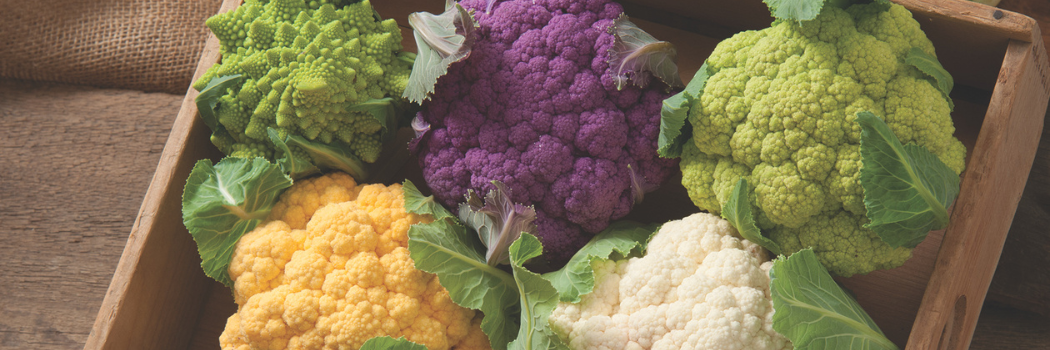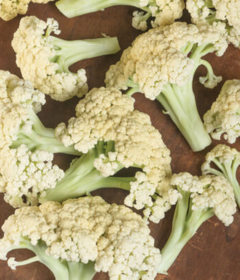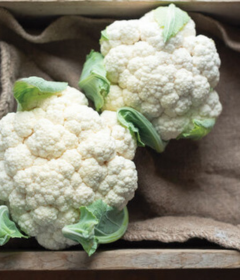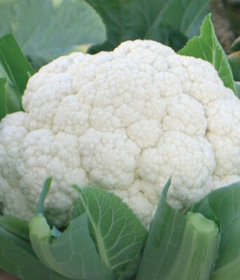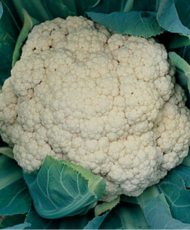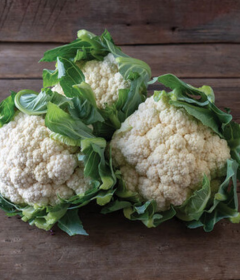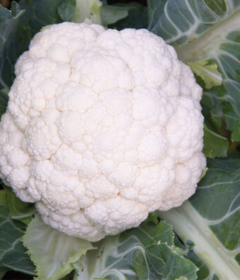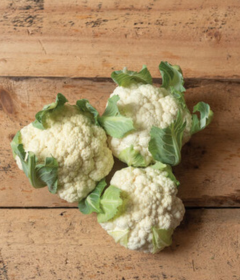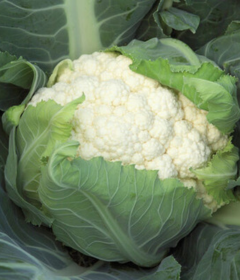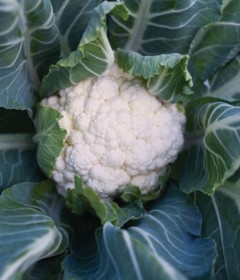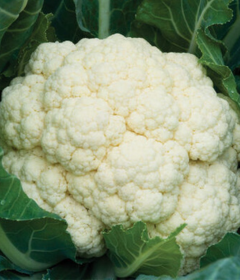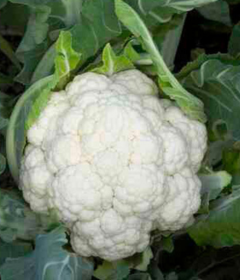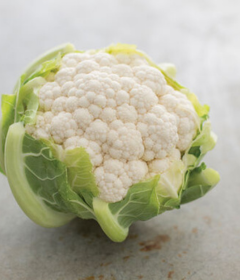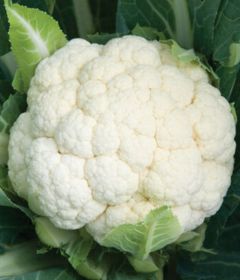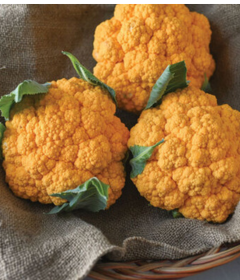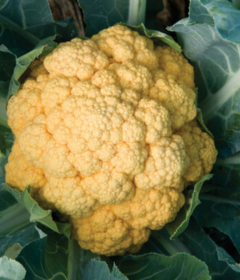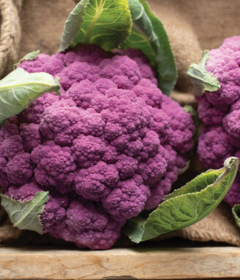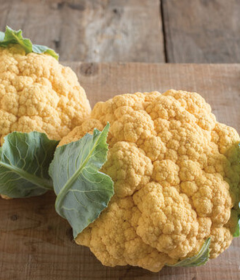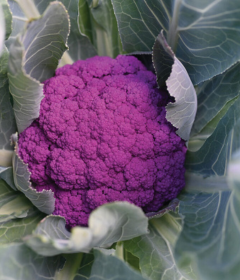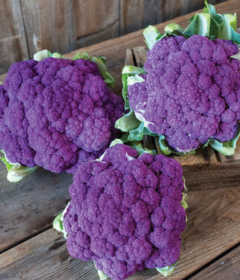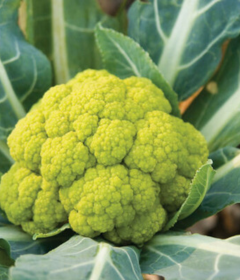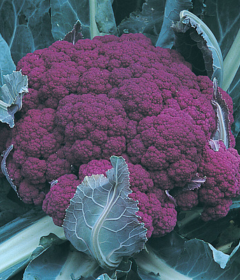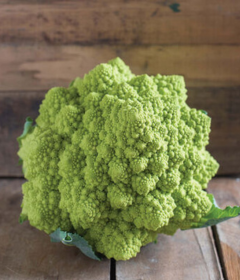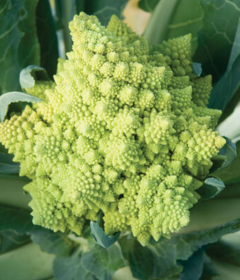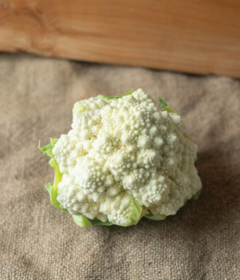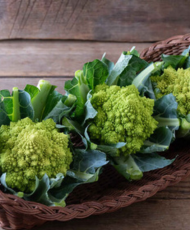- Cauliflower Varieties | Planting Program Comparison Chart & Blanching Tips
- Cauliflower Varieties | Comparison Chart / Planting Program (PDF)
- Cauliflower | Key Growing Information
- Cauliflower Production | Tech Sheet (PDF)
- Success with Brassicas | Advice on Timing, Temperature, Fertility & Watering
- Common Brassica Pests & Diseases | Johnny's Selected Seeds
- Johnny's Planting & Harvesting Programs
Succession Planting Program: Cauliflower Varieties
Succession Planting & Season Extension for Cauliflower
Successive plantings of different cauliflower varieties in the appropriate seasonal slots and sequence will allow you to maximize your yield, quality, and harvest window. Choose from a dozen cauliflower varieties by type, days-to-maturity, heat and cold tolerance, color, and optimal sowing/harvesting periods.
Succession Planting & Harvesting Chart • Cauliflower |
|||||||||
|---|---|---|---|---|---|---|---|---|---|
| Transplant | Harvest | ||||||||
| Variety | Cool/Spring | Warm/Summer | Cool/Fall | Cold/Winter | |||||
| Standard White Cauliflower | |||||||||
| 'Song TJS-65' | |||||||||
| 'Earlisnow' | |||||||||
| 'Fujiyama' | |||||||||
| 'Snow Crown' | |||||||||
| 'Tessaury' | |||||||||
| 'Synergy' | |||||||||
| 'Twister' | |||||||||
| 'Bishop' | |||||||||
| 'Paxton' | |||||||||
| 'Amazing' | |||||||||
| 'Denali' | |||||||||
| 'Sierra Madre' | |||||||||
| 'Skywalker' | |||||||||
| Non-White Standard Cauliflower | |||||||||
| 'Clementine' | |||||||||
| 'Cheddar' | |||||||||
| 'Amethyst' | |||||||||
| 'Flame Star' | |||||||||
| 'Purple Moon' | |||||||||
| 'Lavender' | |||||||||
| 'Vitaverde' | |||||||||
| 'Graffiti' | |||||||||
| Romanesco Cauliflower | |||||||||
| 'Puntoverde' | |||||||||
| 'Veronica' | |||||||||
| 'Whitaker' | |||||||||
| 'Delaverde' | |||||||||
Variety Comparison Chart • Cauliflower |
|||||
|---|---|---|---|---|---|
| Variety | Notes | Days to Maturity | Heat tolerance | Cold Tolerance | Color |
| Standard White Cauliflower | |||||
| 'Song TJS-65' | Performs better in heat and below-average fertility and sweeter and more tender than standard white-stemmed, heading cauliflowers. | 42 | Very good | Good | White with green stems. |
| 'Earlisnow' | Reliable, widely adaptable first-early. Produces medium-size plants with average wrapping of heads. | 45 | Very good | Good | White |
| 'Fujiyama' | Superior heat tolerance. | 45 | Excellent | Poor | White |
| 'Snow Crown' | Extra early and adaptable. Medium-size heads. AAS Winner. | 50 | Good | Good | White |
| 'Tessaury' | Heat tolerant organic cauliflower. | 58 | Very good | Good | White |
| 'Synergy' | Adaptable; large heads mature between 'Snow Crown' & 'Bishop'. | 60 | Good | Good | White |
| 'Twister' | Superior wrap and adaptability. Big heads with large, protective wrapper leaves. | 62 | Very good | Good | White |
| 'Bishop' | For summer and fall crops. Vigorous and widely adaptable. Produces well-wrapped heads. | 65 | Very good | Good | White |
| 'Paxton' | For summer and fall-harvested crops. High resistance to club root races 0–2. Produces large, welf-wrapping heads. | 67 | Very good | Good | White |
| 'Amazing' | Tolerant to both heat and cold stress. Plants produce self-blanching, upright wrapper leaves when well-fed. | 68 | Good | Good | White |
| 'Denali' | For fall production; widely adapted. Large, self-wrapping heads. | 73 | Good | Excellent | White |
| 'Sierra Madre' | Overwintering variety for the West Coast. | 73 | Very good | Very good | White |
| 'Skywalker' | Best organic variety for late summer and fall harvest. Medium-size, self-wrapping heads. | 80 | Average | Very good | White |
| Standard Non-White | |||||
| 'Clementine' | Produces big and sturdy plants, even under less-than-ideal conditions. Earliest orange variety for summer and fall harvest. | 55 | Very good | Good | Vibrant orange |
| 'Cheddar' | Beautiful, early, and orange; holds well in the field and retains color upon cooking. | 58 | Very good, but less than 'Flame Star' | Good | Orange |
| 'Amethyst' | Extra-early purple cauliflower. | 59 | Good | Good | Purple |
| 'Flame Star' | Favorable tolerance to heat and stress. Performs very well in both spring and fall. | 62 | Very good | Good | Pastel-orange |
| 'Purple Moon' | Widely adapted: exceptionally early; best-performing purple variety in warm weather; excellent fall crop. | 62 | Good | Good | Purple |
| 'Lavender' | Performs best for fall crops but may also be grown successfully for summer crops. | 70 | Good | Good | Violet |
| 'Vitaverde' | Large and heavy heads. Suitable for both cool and warm weather production. | 71 | Very good | Very good | Green |
| 'Graffiti' | Best for fall harvest, but also can be sown in spring. Produces true cauliflower heads on large plants. | 80 | Very good | Very good | Purple |
| Romanesco Cauliflower | |||||
| 'Puntoverde' | Most reliable all-season Romanesco. | 78 | Very good | Good | Green |
| 'Veronica' | Summer plant for fall to midwinter harvest. | 78 | Poor | Good | Green |
| 'Whitaker' | First white hybrid Romanesco. | 80 | Good | Average | White |
| 'Delaverde' | Romanesco for short-day crops. | 83 | Good | Good | Green |
Cauliflower Photo Comparison
Tech Tip: How to Blanch White Cauliflower Varieties
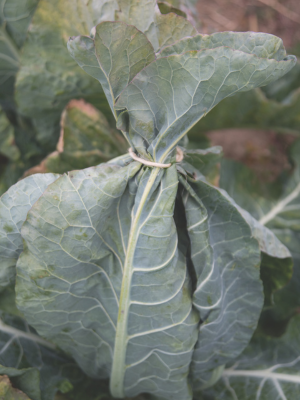
Blanching white cauliflower
Exposure to the sun can cause the heads of white cauliflower varieties to turn yellow or light purple. Some varieties are self-wrapping, which helps prevent this process from occurring. For varieties that are not self-wrapping, a simple blanching method can be used to produce the creamy-white heads that many look for in cauliflower. Follow these tips for uniformly white heads.
- The time to begin blanching is when the developing heads are just visible through the leaves, about 1–2" in diameter.
- Gather the outer wrapper leaves and pull them over the heads, securing them together with twine, clothespins, or a rubber band.
- Another method is to crack the midribs of the leaves and fold them over the head until it is completely covered. Do not break the leaves, or they may blow away.
- Check the heads as they develop. Tied or covered heads may be subjected to increased humidity levels, increasing their susceptibility to Alternaria.
- Blanching becomes less important in the cooler, shorter days of fall.
Note there is no need to tie the leaves around the heads of colored cauliflower varieties—to achieve their rich coloration they require exposure to light!


